Squirrels may be cute, but their destructive habits can wreak havoc on your garden, home, and property. From digging up flower beds to chewing through wires in your attic or even damaging your vehicle, these persistent rodents can cause significant problems. This comprehensive guide provides proven methods to repel squirrels effectively and humanely, featuring the best squirrel repellent products on the market in 2025, along with practical prevention strategies to keep your property squirrel-free.
Quick Picks: Best Squirrel Repellents

Editor’s Choice
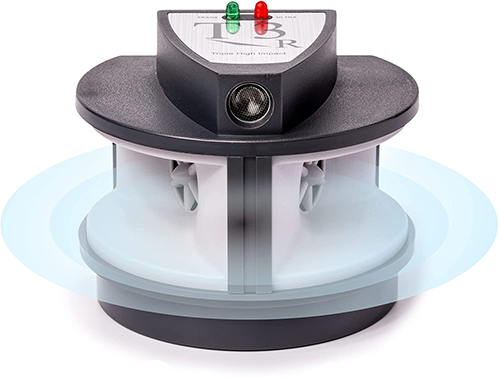
Best Electronic
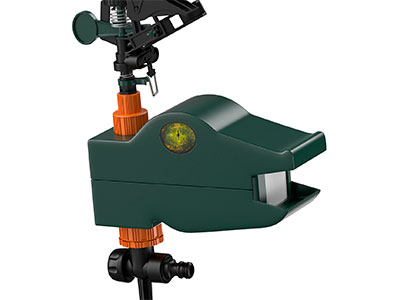
People’s Choice
- Signs of Squirrel Infestation
- Types of Squirrel Repellents
- Best Natural Squirrel Repellents
- Electronic Squirrel Repellents
- Motion-Activated Repellents
- Physical Barriers and Exclusion Methods
- Bird Feeder Protection Strategies
- Advantages and Disadvantages of Different Repellent Types
- DIY Squirrel Repellent Solutions
- Trapping as a Squirrel Control Option
- Frequently Asked Questions
- Conclusion
Signs of Squirrel Infestation
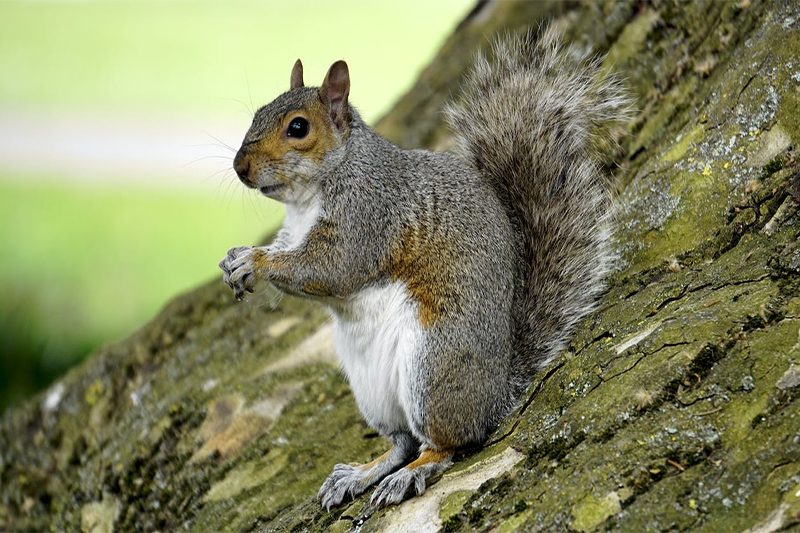
Before discussing repellent options, it’s important to identify if you have a squirrel problem. These rodents typically start by invading your garden and can quickly move to your attic, where they tear up insulation to create nesting areas.
The greatest danger from squirrel infestations is the fire hazard they create by chewing on electrical wires in your walls and attic.
Common signs of squirrel activity include:
- Urine or feces deposits in your attic or crawl spaces These leave distinctive odors and can create staining on ceilings.
- Chewed wires and cables Particularly concerning in walls and attics where they pose significant fire hazards.
- Damaged screening on vents or roof access points Squirrels often create entry points by tearing through these barriers.
- Roof or siding damage Persistent gnawing can create structural issues over time.
- Disturbed garden areas Digging around plants, bulbs, and flower beds is a classic sign of squirrel activity.
- Emptied bird feeders Squirrels are notorious for raiding bird feeders and can empty them rapidly.
Types of Squirrel Repellents
There are several categories of squirrel repellents available, each with its own advantages and applications. Understanding the differences will help you choose the most effective solution for your specific situation.
| Repellent Type | Best For | Advantages | Considerations |
|---|---|---|---|
| Natural Spray Repellents | Gardens, exterior surfaces, plants | Eco-friendly, safe around children and pets | Need reapplication after rain, regular maintenance |
| Granular Repellents | Lawns, garden perimeters, flower beds | Longer-lasting than sprays, easy to distribute | May have strong odors, need replacement after 30-60 days |
| Electronic Ultrasonic Repellers | Indoor spaces, attics, garages | No chemicals, maintenance-free, long-lasting | Limited range, may affect pets, varying effectiveness |
| Motion-Activated Devices | Yards, gardens, outdoor spaces | Immediate deterrent effect, covers wide areas | Requires water connection, seasonal limitations |
| Physical Barriers | Garden beds, tree trunks, specific areas | Very effective, long-term solution | Labor-intensive installation, may affect aesthetics |
Best Natural Squirrel Repellents
Natural repellents use plant-based ingredients to create scents and tastes that squirrels find unpleasant. These are ideal for gardens, homes with children and pets, or anyone preferring an eco-friendly approach.
How Natural Repellents Work
Natural squirrel repellents typically work through two primary mechanisms:
- Scent-based deterrence: Squirrels have a highly developed sense of smell and avoid areas with odors they find threatening or unpleasant. Common effective scents include predator urine, peppermint, garlic, and certain essential oils.
- Taste-based deterrence: These products create an unpleasant taste experience for squirrels when they try to chew on treated items or plants. Capsaicin (hot pepper), bitter agents, and certain plant extracts are commonly used.
Home remedies like coffee grounds, garlic spray, or pet hair can be effective temporary deterrents. Sprinkle coffee grounds around flower beds or mix crushed garlic with water and vinegar in a spray bottle. Collect pet hair from your vacuum cleaner and distribute it around your yard to simulate predator presence.
I Must Garden Squirrel Repellent
Editor's ChoiceHow Does It Work
How to Use
- Shake well before each use for proper ingredient distribution
- Spray liberally on surfaces squirrels frequently damage including plants, outdoor furniture, siding, and garden beds
- Apply around the perimeter of areas you want to protect
- Reapply every 30 days or after heavy rainfall
- For best results, apply before squirrels establish feeding patterns in an area
- Contains 100% natural ingredients safe for people, pets, and plants
- Dual-action protection targeting both smell and taste
- No unpleasant odor for humans while being highly effective against squirrels
- Made in the USA with eco-friendly formulation
- Won't wash away easily after light rain
- Requires regular reapplication, especially after heavy rainfall
- May need more frequent application in areas with high squirrel pressure
- Works best as a preventative measure rather than removing existing nests
Electronic Squirrel Repellents
Electronic repellents offer technological solutions to squirrel problems through various mechanisms like ultrasonic sounds, motion activation, or other sensory deterrents.
How Electronic Repellents Work
Electronic squirrel repellents operate by creating an environment that squirrels find stressful or threatening. These devices typically use one or more of the following technologies:
- Ultrasonic sound waves: These devices emit high-frequency sounds (typically 25kHz-65kHz) that are irritating to squirrels but inaudible to humans. Research has shown that squirrels can hear frequencies up to 49kHz.
- Electromagnetic fields: Some devices create electromagnetic disturbances that squirrels find disorienting or uncomfortable.
- Motion-activated mechanisms: These detect movement and trigger deterrent actions like water sprays, sounds, or lights.
Squirrels can hear sounds from 113 Hz to 49 kHz, while humans can only hear up to 20 kHz. Electronic repellents exploit this difference by emitting sounds in unpredictable patterns that confuse and stress squirrels, encouraging them to leave the area.
T3-R Triple High Impact Rodent Repeller
Best ElectronicHow Does It Work
How to Use
- Simply plug the unit into any standard electrical outlet
- Position the device in the area where squirrel activity has been detected
- For best results, place the unit at the same height as typical squirrel activity
- Ensure furniture or other objects don't block the sound waves
- Allow 1-2 weeks for full effectiveness as squirrels adjust their behavior
- Extensive coverage area of up to 6,000 square feet
- Triple-speaker design provides 360-degree protection
- No chemicals or poisons, making it safe for households with pets and children
- Maintenance-free operation with no refills or batteries needed
- Silent operation to human ears while highly effective against rodents
- Requires continuous power supply through electrical outlet
- May take 1-2 weeks to see full results as squirrels adjust their behavior
- Effectiveness can be reduced if sound waves are blocked by furniture or walls
- May not deter squirrels that have already established nests with offspring
When selecting an electronic repellent, look for these key features:
- Durable casing: Squirrels love to chew, so choose devices with robust exteriors.
- High-frequency rating: For optimal effectiveness against squirrels, aim for at least 50kHz.
- Wide coverage area: Select devices that cover your entire problem area or purchase multiple units.
- 360-degree protection: Ensure the sound emits in all directions for complete coverage.
- Multiple deterrent features: Some devices combine ultrasonic with lights or other deterrents for enhanced effectiveness.
| Feature | T3-R Repeller | DIAOTEC Ultrasonic | MaxMoxie Repeller |
|---|---|---|---|
| Coverage Area | 6,000 sq ft | 5,000 sq ft | 1,200 sq ft |
| Frequency Range | Specially designed frequencies | 25kHz-65kHz | Multiple frequencies |
| Power Source | Standard outlet | DC 9V | Standard outlet |
| Special Features | Triple speaker design | 360° emission angle | Controllable night-light |
| Best For | Large indoor spaces, attics | Attics, garages, basements | Smaller rooms, apartments |
Motion-Activated Repellents
Motion-activated solutions offer an interactive approach to repelling squirrels by triggering deterrent mechanisms only when movement is detected.
Hoont Motion Activated Jet Blaster
People's ChoiceHow Does It Work
How to Use
- Connect the device to your garden hose using the included fittings
- Position the sprinkler in areas with known squirrel activity
- Adjust the sensitivity settings based on your specific needs
- Set the spray distance and pattern to cover your target protection area
- The unit will automatically detect and deter squirrels 24/7
- 100% humane method that causes no harm to animals
- Effective against multiple pest animals including squirrels, raccoons, and deer
- Covers a substantial area of up to 650 square feet
- Adjustable sensitivity and spray patterns for customized protection
- No chemicals or baits required
- Solar powered with battery backup for continuous operation
- Requires connection to water supply
- May not be practical during freezing weather
- Water usage increases with frequent activations
- May occasionally be triggered by non-target movement like falling leaves
Physical Barriers and Exclusion Methods
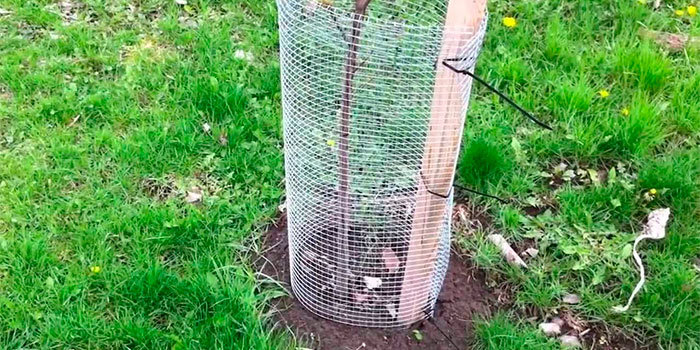
While repellents help deter squirrels, physical barriers can prevent access to specific areas entirely. These methods work well in combination with repellents for comprehensive protection.
Effective Barrier Methods
- One-way doors: These allow squirrels to exit your home but prevent re-entry. To implement:
- Identify all entry/exit points in your roof or walls
- Seal all but one or two points
- Install one-way doors at the remaining openings
- After all squirrels have left, seal the remaining openings
- Chicken wire barriers: For garden protection:
- Dig around planting beds
- Line with chicken wire on the bottom and sides
- Extend wire above the bed’s top if needed
- This prevents squirrels from digging under or climbing over
- Aluminum flashing for trees:
- Wrap 60cm wide aluminum flashing around tree trunks
- Attach with stainless steel nails (only 2.5cm into the tree)
- This prevents squirrels from climbing trees to access roofs or feeders
- Electric fences: For serious garden protection:
- Use a low wire mesh fence (about 18 inches high)
- Combine with electric wires that deliver a mild shock
- Space posts 5-12 feet apart depending on your garden’s terrain
- Position wires starting close to the ground, spaced 3-4 inches apart
- Use at least 3 wires to prevent squirrels from jumping through
Barrier Components
- Ground system
- Plastic/metal/fiberglass posts
- Fence charger
- Connectors
- Insulators
- Poly tape/poly wire
Garden Protection
- Cover bulbs with chicken wire
- Use squirrel-proof bird feeders
- Apply repellent sprays to perimeters
- Plant squirrel-deterring flowers
- Create buffer zones with gravel
Home Protection
- Seal entry points with steel mesh
- Trim tree branches away from roof
- Install chimney caps
- Use ultrasonic repellers in attics
- Apply repellent near potential entries
Bird Feeder Protection Strategies
Bird feeders often attract squirrels, who can quickly empty them of seed meant for birds. Here are effective strategies to keep squirrels away from your feeders:
- Create physical gaps: Position feeders at least 10 feet away from any jumping point like trees or structures.
- Use lubricants: Apply petroleum jelly or specialized pole lubricants to make climbing surfaces slippery.
- Install baffles: Place cone-shaped barriers above and below feeders to prevent access.
- Choose squirrel-proof feeders: These have mechanisms that close feeding ports when a squirrel’s weight is detected.
- Use metal construction: Avoid plastic feeders that squirrels can chew through.
Many bird feeders now feature electronic deterrence with weight-sensitive perches that administer a mild shock to squirrels while allowing birds to feed normally. These sophisticated devices are highly effective at training squirrels to avoid your feeders.
Advantages and Disadvantages of Different Repellent Types
When selecting squirrel repellents, it’s helpful to understand the pros and cons of each type of repellent to make an informed decision.
| Repellent Type | Advantages | Disadvantages |
|---|---|---|
| Natural Sprays |
|
|
| Granular Repellents |
|
|
| Electronic Repellers |
|
|
| Motion-Activated Devices |
|
|
DIY Squirrel Repellent Solutions
If you prefer to make your own squirrel repellents, these homemade solutions can be effective and economical alternatives:

- Mix 1 tablespoon of cayenne pepper with 2 cups of water
- Add a few drops of dish soap to help mixture stick to surfaces
- Spray directly on affected areas and plants
- Reapply after rain or every 3-5 days

- Crush 4-5 garlic cloves and steep in 2 cups of hot water
- Add 1 cup of vinegar after mixture cools
- Strain and transfer to spray bottle
- Apply to garden perimeter and problem areas
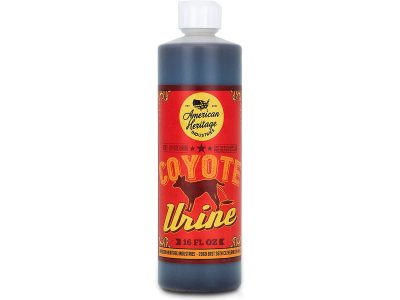
- Purchase predator urine (fox or coyote) from garden centers
- Apply around property perimeter using cotton balls
- Place in waterproof containers to extend effectiveness
- Refresh every 2-3 weeks for continuous protection
When making homemade repellents, always wear gloves and avoid inhaling sprays, particularly those containing hot peppers which can cause respiratory irritation. Keep these solutions away from children, and wash hands thoroughly after handling ingredients. Never spray homemade solutions directly on food crops without washing thoroughly before consumption.
Trapping as a Squirrel Control Option
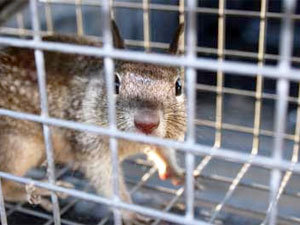
When repellents alone aren’t sufficient, humane trapping can be an effective method for removing persistent squirrels from your property. Once trapped, it’s essential to relocate the squirrels to a safe distance to prevent their return. Additionally, implementing barriers and protective measures can help keep squirrels away from gardens, ensuring your plants remain undisturbed. Regular maintenance and monitoring of your property will further discourage these persistent visitors.
Live Trapping Methods
Live trapping allows you to capture squirrels without harm and relocate them to more suitable habitats:
- Metal cage traps are most effective and durable
- Position traps along known squirrel pathways or near entry points
- Bait with appealing foods like peanut butter, nuts, or apple slices
- Check traps frequently to minimize stress to captured animals
- Transport and release squirrels at least 5 miles away in suitable habitat
After removing squirrels via trapping, it’s essential to seal entry points and implement preventative measures to avoid re-infestation.
Spend time observing how squirrels access your home. Their entry holes are often much smaller than expected – sometimes as small as 1.5 inches in diameter. Identifying and sealing these access points is crucial for long-term control.
Frequently Asked Questions
Does peppermint oil repel squirrels?
Yes, peppermint oil is an effective natural squirrel repellent. Squirrels dislike the strong menthol scent of peppermint oil, making it useful for deterring them from gardens, attics, and vehicles. For best results, apply concentrated peppermint oil (4% or stronger) to cotton balls and place them in problem areas, or use a spray solution around the perimeter of areas you want to protect.
Peppermint oil is safe for use around pets and family members, but should be reapplied every few days and after rainfall to maintain effectiveness.
What smells do squirrels hate the most?
Squirrels have a highly developed sense of smell and are particularly averse to several scents that can be used as natural deterrents. The most effective odors that repel squirrels include:
- Predator urine (fox, coyote)
- Peppermint oil
- Garlic
- White pepper
- Vinegar
- Coffee grounds
- Capsaicin (hot pepper)
Commercial repellents often combine several of these scents for maximum effectiveness. For DIY solutions, consider using these ingredients in sprays or scattered around problem areas.
Are ultrasonic repellers safe for pets?
Ultrasonic repellers can affect domestic pets differently depending on the frequency range and your pet species. Most dogs can hear frequencies up to 45 kHz and cats up to 85 kHz, while squirrels hear up to 49 kHz. If you have pets, look for devices with adjustable frequencies above 45 kHz to minimize effects on dogs, or place units in areas your pets don’t frequently access.
Quality ultrasonic repellers should specify their frequency range and include pet safety information. If you notice your pets exhibiting signs of distress after installation (excessive barking, anxiety, avoidance behaviors), consider relocating the device or switching to a different type of repellent.
How long do squirrel repellents last?
The longevity of squirrel repellents varies by type:
- Spray repellents: 2-4 weeks, requiring reapplication after heavy rain
- Granular repellents: 30-60 days under normal conditions
- Electronic repellers: 3-5 years of continuous operation
- Motion-activated devices: 2-5 years depending on usage and exposure to elements
- DIY solutions: 3-7 days, needing frequent reapplication
For optimal protection, establish a regular maintenance schedule based on the type of repellent you’re using and local weather conditions.
Can I use squirrel repellents on edible plants?
If using repellents on or near edible plants, only use food-safe natural products specifically labeled for such use. Many commercial repellents contain ingredients that aren’t suitable for food crops. For edible gardens, consider these alternatives:
- Physical barriers like fencing or netting
- Motion-activated sprinklers positioned around (not directly on) garden beds
- Companion planting with squirrel-deterring plants like mint, marigolds, or daffodils
- Food-grade diatomaceous earth sprinkled around plants (not directly on edible portions)
Always thoroughly wash any fruits or vegetables before consumption, even when using natural repellents.
After it rains, should you reapply natural repellents?
Yes, after rain you should reapply natural repellents, especially spray and powder formulations. Rain washes away the active ingredients, significantly reducing their effectiveness. For optimal protection, reapply natural repellents:
- After any significant rainfall
- Every 2-3 weeks during normal weather
- More frequently in areas with heavy squirrel activity
Some granular products are more water-resistant and may only need reapplication after heavy or prolonged rain. Follow product-specific instructions for best results.
Conclusion
Controlling squirrel populations requires a multi-faceted approach combining the right repellents with preventative measures. The best squirrel repellent strategy will typically involve: Implementing physical barriers, such as netting and fencing, is essential to protect gardens and plants. Additionally, creating the best squirrel proof garden cage can significantly reduce the likelihood of squirrels damaging your crops. Regular maintenance and monitoring of these strategies will ensure long-term success in keeping squirrel populations at bay.
- Identifying problem areas where squirrels are causing damage
- Selecting appropriate repellents based on your specific situation
- Implementing physical barriers to restrict access
- Removing attractants that draw squirrels to your property
- Maintaining consistent application of your chosen solutions
By combining multiple deterrent methods and remaining persistent in your efforts, you can effectively manage squirrel problems while maintaining ecological balance. Remember that humane approaches are not only ethically preferable but often more effective in the long term.
For persistent or severe infestations, consider consulting with a professional wildlife control service that specializes in humane removal and exclusion techniques.

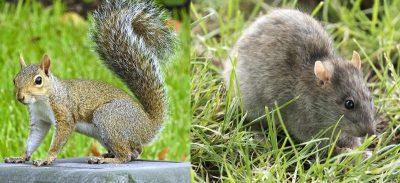
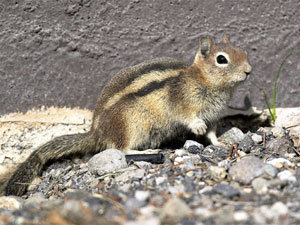

I’m really looking for a mild shock
system to deter squirrels from accessing my birdfeeders.
Using large predator urine only causes more of the same species to come urinate on top of the same spot. You end up with a big stink and no relief from the squirrels. If you have small pets they become prey for the predators nw that you have attracted them to frequent your yard.
Hello, How Can I Protect GroundNuts From Squrrels? Pliz Help Me.
I use an air rifle, .22 Cal. It is quite effective out to about 60 yards.
When I find a gopher or ground squirrel hole I give them a Giant Destroyer, 20 minutes after the Giant Destroyer has gone off I will put the muzzle of a .69 cal. 12 pound Napoleon cannon, .made by CVA years ago, loaded with 90 grains FFG black powder a very tight paper wad pounded on top of the powder. I had put a 3″ fuze in the flash hole. The muzzle in the hole will have dirt packed tightly around it and the fuze lit. The cannon goes off quietly in aboutr 30 seconds.
It will give the rodents a head ache, or concuss them
I have tried everything! I’ve tried mothballs and learned they are toxic. I threw 3 boxes in the attic, a sound solar machine, ammonia rags, lime, white pepper, cayenne pepper, Critter Ridder, tons of sprays for squirrels. Furthermore, I am exhausted and frustrated. I’ve contacted a company to see what they can do. I am going to cut the trees to my house, but I saw one come over my fence. Pleaseeeeeee someone help me with info. A BB gun is not the answer. I appreciate your time and solution. Thanks
Most Adult Humans can’t hear ultrasonics, but some can, as Anonymous said, small children can in most cases hear them. Humans tend to lose most ultra high frequency capability between the average ages 14 ~ 30 as the cochlear hair cells die within the ear. I’m over 30 and still have good ultra high frequency range hearing, just not quite as good as it once was. I can hear most of the ultrasonic pest repellents on the market, further some of the electronic circuitry in modern switch mode power supplies is quite audibly noisy. Think poorly made replacement laptop power bricks as an example. The real problem with most ultrasonic pest repellents is that, most on the market do not cycle or change the frequency used and thus the rodents become accustomed to the consistent frequency of the noise in that environment and it no longer appears threating.. so they move back in. If you have a variable frequency intermittent emitting device they tend to be quite effective.. few are built this way.
How can I order RODAR II Ultrasonic Pest Repeller
It’s a well known fact that some small children can hear these sounds.
question, does the Havahart Spray Away repellent work? Products are advertised, however I do not hear any success stories. If anyone has used any repellents, pls add to comments as to the results. Stop repeating yourselves.not interested in reading childlike comments. Looking for straight answers, not criticism.
Critter Ritter does not work.
This year we have been run over by squirrels. We have read on several sites trying different things. We have trapped 51 squirrels in 10 days. They have destroyed our yard and grove. I have found that putting peanut butter on crackers and some nuts have helped to capture them in the trap/cage. They are still plenty more to go though.
I am interested in trying the most effective product. Which of these serves that purpose. I have tried the ultrasonic type but the squirrels seem to be immune. The are now in an unused chimney.
Wow! There are all kinds of rodents, including human ones, that need repelling.
electronic repellers is a absolute insult to families they keep my grandchildren away and my neighbors awake please take them out of free WILL from selling and off the market I feel I is fraud or the LAW has to step in
many products listed here look good but none of them mention if they are safe or repellant to birds? we want to keep the birds and repel the squirrels is there a product that does this task? thank you for your helpful site. DW